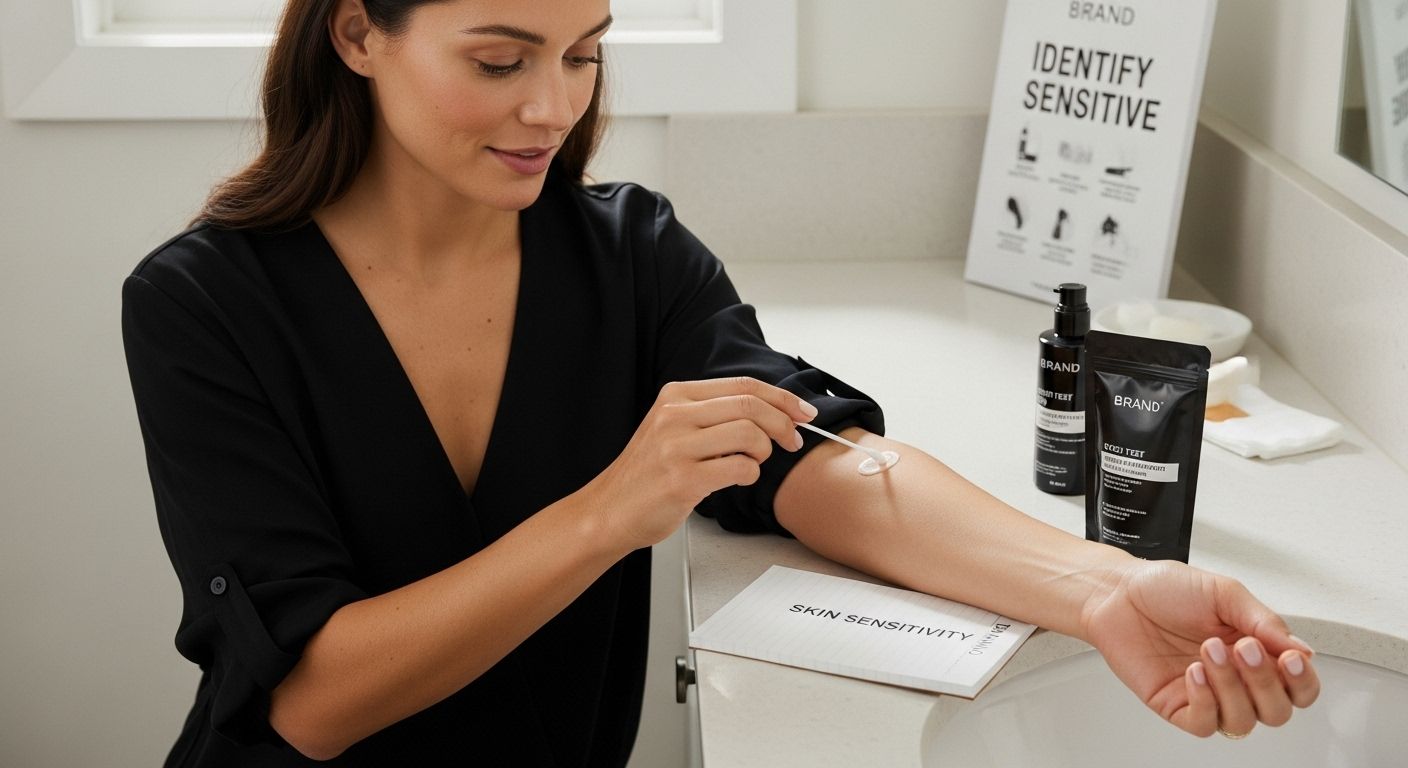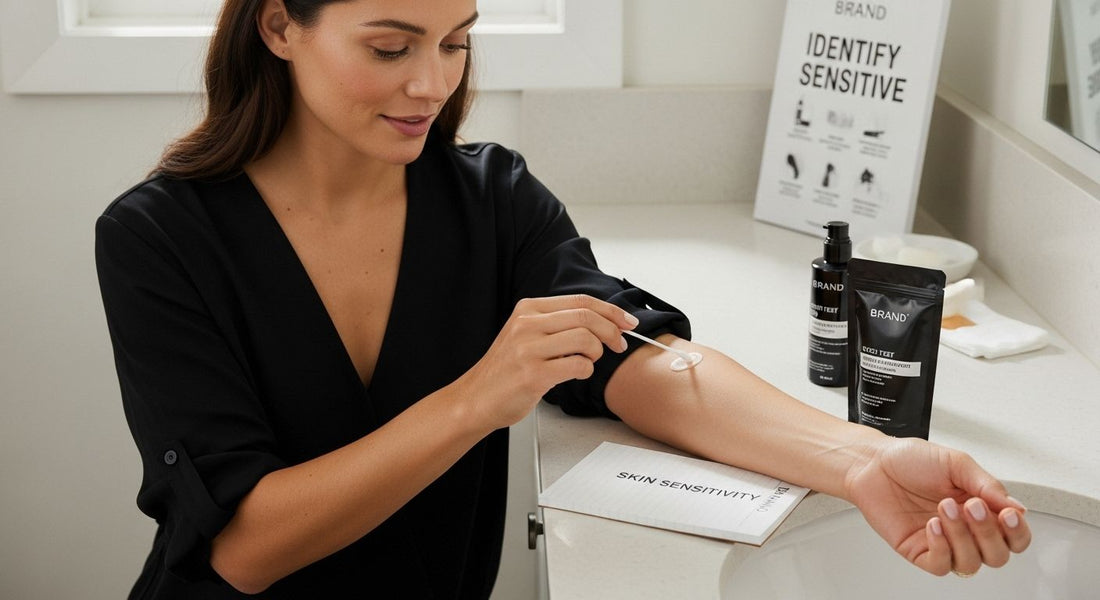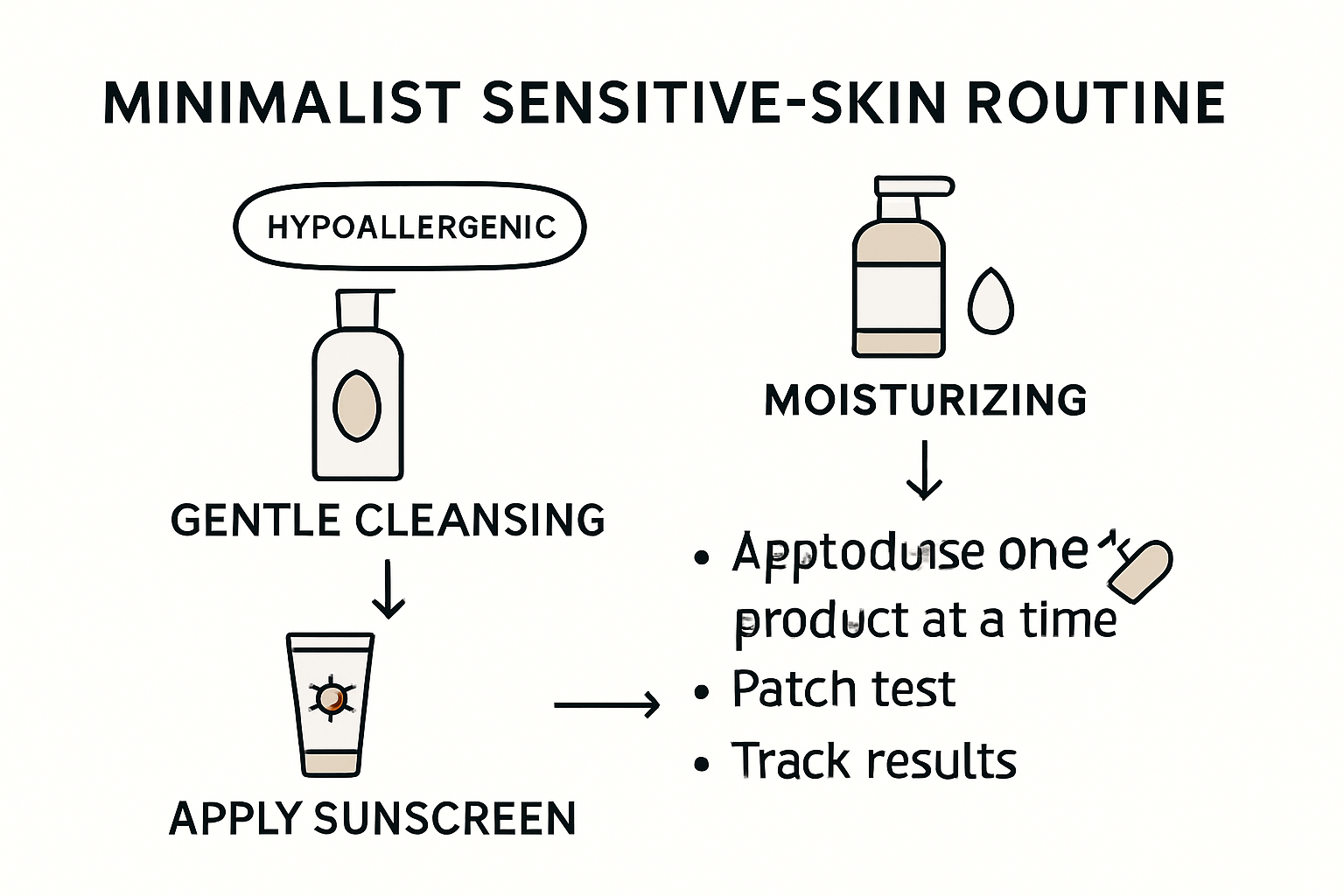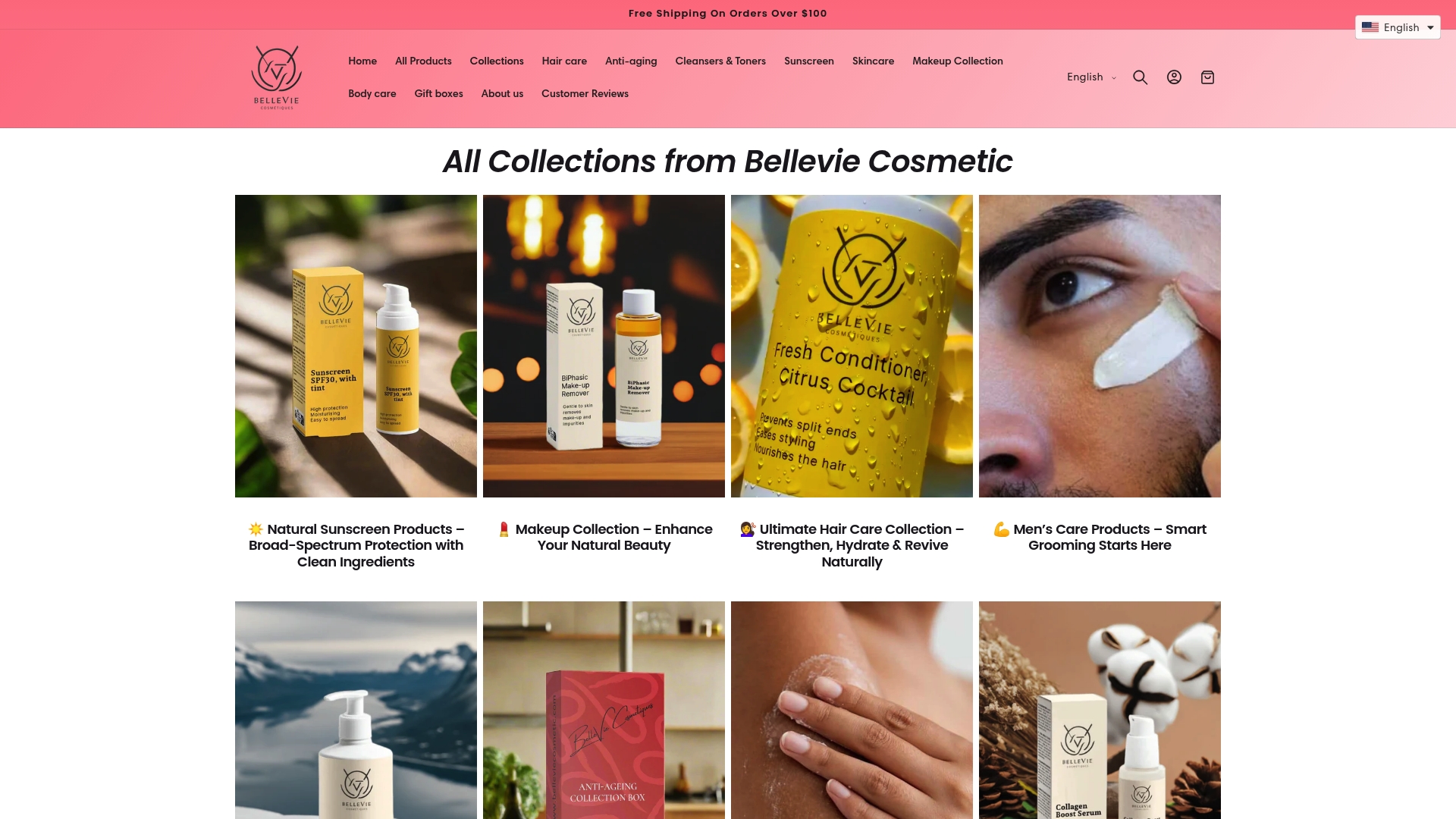Sensitive skin can turn even the simplest skincare routine into a guessing game. Most people think a fancy label or natural-sounding ingredient will do the trick, yet reactions still happen with surprising frequency. Nearly 60% of women and 40% of men describe their skin as sensitive according to recent clinical studies. It sounds overwhelming, but the real secret is that understanding your own sensitivity is the first and most overlooked step. Making this shift can change everything about how your skin behaves.

Table of Contents
- Step 1: Identify Your Skin Type And Sensitivity Level
- Step 2: Recognize Common Triggers And Irritants
- Step 3: Test Products For Compatibility And Reactivity
- Step 4: Create A Tailored Skincare Routine
- Step 5: Monitor Your Skin Over Time For Changes
Quick Summary
| Key Point | Explanation |
|---|---|
| 1. Identify your skin type and sensitivity | Understanding your skin type helps select suitable products and avoid irritation for effective skincare. |
| 2. Maintain a skin trigger journal | Documenting products and environmental changes reveals patterns and helps identify irritants over time. |
| 3. Perform patch tests on new products | Patch testing minimizes adverse reactions by assessing product compatibility before full application. |
| 4. Create a minimalist skincare routine | Focus on gentle, hypoallergenic products to support sensitive skin without overwhelming it. |
| 5. Continuously monitor skin changes | Regular tracking of skin conditions and responses aids in adapting your skincare routine as your skin evolves. |
Step 1: Identify Your Skin Type and Sensitivity Level
Understanding how to understand skin sensitivity starts with a crucial first step: accurately identifying your unique skin type and sensitivity threshold. This foundational assessment will guide every subsequent skincare decision, helping you select products that nourish rather than irritate.
Your skin’s sensitivity is not a one-size-fits-all diagnosis. Some individuals experience immediate reactions to new products, while others develop sensitivity gradually. Begin by observing how your skin responds to environmental changes, skincare products, and everyday stimuli.
To effectively assess your skin sensitivity, conduct a comprehensive self-evaluation. Look for telltale signs like redness, burning sensations, itching, or tightness after product application. These symptoms indicate that your skin might lean towards the sensitive end of the spectrum. Pay special attention to how your skin reacts during temperature changes, after cleansing, or when exposed to new cosmetic formulations.
According to research published in Clinical, Cosmetic and Investigational Dermatology, sensitive skin often manifests through specific physiological responses. Key indicators include:
- Heightened reactivity to topical products
- Increased skin irritation threshold
- Persistent redness or inflammation
- Quick onset of stinging or burning sensations
Consider performing a patch test when introducing new skincare products. Apply a small amount of the product to a discrete area like your inner forearm and monitor the skin’s response over 24-48 hours. Watch for any signs of adverse reactions such as:
- Immediate redness
- Swelling
- Persistent itching
- Tiny bumps or rash development
If you experience multiple sensitivity indicators, you likely have sensitive skin that requires gentle, carefully selected skincare formulations. Your goal is not to eliminate skin sensitivity entirely but to understand and manage it effectively. By recognizing your skin’s unique characteristics, you can develop a personalized skincare strategy that supports your skin’s health and resilience.
Remember, skin sensitivity is dynamic and can change with factors like age, hormonal shifts, stress levels, and environmental conditions. Regular self-assessment and adaptability are key to maintaining optimal skin health and comfort.
Step 2: Recognize Common Triggers and Irritants
Identifying your skin sensitivity means becoming a detective of personal triggers and hidden irritants that can provoke unwelcome skin reactions. Understanding these potential culprits empowers you to make informed skincare choices and protect your skin’s delicate balance.
The world around you is filled with potential skin irritants, often lurking in unexpected places. Household products, environmental factors, and personal care items can silently challenge your skin’s resilience. Your clothing, laundry detergents, cosmetics, and even stress can contribute to skin sensitivity.
According to Cleveland Clinic, common triggers span multiple categories. Clothing fabrics like wool and synthetic materials can mechanically irritate sensitive skin. Household cleaning products, makeup, and personal care items frequently contain harsh chemicals that disrupt your skin’s natural protective barrier.
To systematically track your skin’s reactions, consider maintaining a detailed skin trigger journal. Document every product you use, environmental conditions, and corresponding skin responses. Look for patterns that reveal your unique sensitivity profile. Pay special attention to:
- Fragranced products
- Alcohol-based cosmetics
- Harsh chemical cleansers
- Synthetic fabric clothing
- Extreme temperature changes
Environmental factors play a significant role in skin sensitivity. Sudden temperature shifts, low humidity, wind exposure, and air conditioning can compromise your skin’s protective barrier. Indoor heating during winter and high-intensity air conditioning in summer can strip moisture, leaving skin vulnerable to irritation.
Common Triggers and Irritants Table
The following table organizes common skin sensitivity triggers and irritants discussed in the article, helping readers quickly identify what to watch out for in their environment and skincare products.
| Trigger/Irritant | Category | Typical Sources |
|---|---|---|
| Fragranced products | Cosmetic/Care Product | Perfumes, scented moisturizers, cleansers |
| Alcohol-based cosmetics | Cosmetic/Care Product | Toners, aftershaves, gels |
| Harsh chemical cleansers | Household/Perso Care | Soaps, detergents, surface cleaners |
| Synthetic fabric clothing | Clothing | Polyester, nylon, blended fabrics |
| Extreme temperature changes | Environmental | Outdoor exposure, HVAC systems |
| Stress | Internal | Emotional or physical stress |
| Parabens, sulfates, additives | Ingredient | Some cosmetics and skincare formulations |
Chemical composition matters immensely. Ingredients like sulfates, parabens, artificial fragrances, and alcohol can trigger inflammatory responses. When shopping for skincare and personal care products, become a meticulous label reader. Look for hypoallergenic, fragrance-free, and minimal ingredient formulations that support sensitive skin.
Stress and hormonal fluctuations can amplify skin sensitivity, creating a complex interplay between emotional well-being and skin health. Recognize that your skin’s reactivity isn’t static but a dynamic system influenced by multiple internal and external factors.
Your goal is not elimination but management. By systematically identifying and minimizing exposure to potential triggers, you create a personalized approach to skin health that respects your skin’s unique characteristics and supports its natural resilience.
Step 3: Test Products for Compatibility and Reactivity
Testing new skincare products requires a strategic and patient approach, especially for those with sensitive skin. Your goal is to minimize potential adverse reactions while systematically evaluating product compatibility. Think of this process as a careful scientific experiment where you are both the researcher and the subject.
The patch test emerges as your primary investigative tool. This methodical approach allows you to assess how your skin responds to new products before applying them extensively. Choose a discrete, less visible area like the inner forearm or behind the ear for testing. Clean this area thoroughly and apply a small amount of the product, creating a controlled environment for observation.
According to American Academy of Allergy, Asthma & Immunology, patch testing helps identify potential allergic reactions. To perform an effective patch test, follow these key guidelines:
- Apply a pea-sized amount of product
- Leave the product undisturbed for 24-48 hours
- Avoid washing or covering the test area
- Check for signs of irritation every few hours
Watch for specific reaction indicators during your patch test. Mild sensitivity might present as slight redness or mild tingling, while more significant reactions could include intense burning, swelling, or persistent itching. These symptoms signal that the product may not be suitable for your skin type.
Document your findings meticulously. Note the product name, ingredients, application date, and specific skin reactions. This detailed record becomes invaluable for understanding your skin’s unique sensitivities and making informed future skincare decisions.

Remember that skin reactivity can change with time. A product you tolerated previously might trigger a reaction later due to changes in your skin’s condition, environmental factors, or your overall health. Regular retesting and mindful observation remain crucial.
If you experience any significant adverse reactions during patch testing, immediately remove the product with lukewarm water and apply a gentle, fragrance-free moisturizer. Persistent or severe reactions warrant consultation with a dermatologist who can provide professional guidance tailored to your specific skin concerns.
Ultimately, patch testing transforms skincare from a guessing game into a calculated, personalized approach. By investing time in this careful evaluation process, you protect your skin from potential harm and build a skincare routine that truly supports your unique dermatological needs.
Step 4: Create a Tailored Skincare Routine
Crafting a personalized skincare routine for sensitive skin is like composing a delicate symphony where each product plays a harmonious role. Your goal is to build a minimalist, gentle approach that supports your skin’s unique needs without overwhelming its natural balance.
Begin by stripping your current routine down to the essentials. Sensitive skin thrives on simplicity, requiring fewer products with carefully selected, mild ingredients. Think of your skincare routine as a carefully curated collection rather than an extensive arsenal of products.
According to the American Academy of Dermatology, an effective skincare routine should focus on fundamental steps that protect and nourish. Your tailored routine will typically include:
Minimalist Skincare Routine Table
Here is a simple table summarizing the essential elements, goals, and examples for building a sensitive skin routine, as described in the article.
| Step | Purpose | Example Product Type | Notes |
|---|---|---|---|
| Cleanser | Gently remove impurities | Fragrance-free cleanser | Avoid sulfates, harsh additives |
| Moisturizer | Hydrate and protect | Non-comedogenic moisturizer | Look for ceramides/hyaluronic acid |
| Sunscreen | Shield from UV rays | Broad-spectrum SPF | Choose for sensitive skin, no fragrance |
| Targeted Treatment | Address specific concerns | Calming serum, spot gel | Introduce slowly, one at a time |
- Gentle, fragrance-free cleanser
- Hydrating, non-comedogenic moisturizer
- Broad-spectrum sunscreen
- Optional targeted treatment for specific concerns
Product selection becomes an art of elimination. Prioritize hypoallergenic, fragrance-free formulations with minimal ingredient lists. Look for products specifically designed for sensitive skin, avoiding potential irritants like alcohol, synthetic fragrances, and harsh exfoliants. Natural, soothing ingredients such as ceramides, hyaluronic acid, and niacinamide can provide gentle support for your skin’s protective barrier.
Consider the sequence and timing of your skincare routine. Morning routines should focus on protection, while evening routines emphasize repair and hydration. Start with the lightest consistency products and progress to heavier formulations. This approach ensures optimal absorption and minimizes potential irritation.
Implement a gradual introduction strategy when incorporating new products. Introduce only one new product at a time, waiting at least two weeks between additions. This methodical approach allows you to accurately identify any potential triggers or adverse reactions. Keep a detailed log documenting each product’s performance, noting changes in skin texture, sensitivity, and overall comfort.
Maintain flexibility in your routine. Skin is dynamic, responding to factors like seasonal changes, stress, hormonal fluctuations, and diet. What works perfectly today might require adjustment tomorrow. Regular reassessment ensures your skincare routine remains responsive to your skin’s evolving needs.
Ultimately, a successful skincare routine for sensitive skin is not about perfection but about understanding and respecting your skin’s unique language. By listening closely, observing carefully, and responding gently, you create a personalized approach that nurtures and protects your skin’s delicate ecosystem.
Step 5: Monitor Your Skin Over Time for Changes
Skin sensitivity is not a static condition but a dynamic landscape that shifts with time, environment, and personal health. Continuous monitoring becomes your most powerful tool in understanding and managing your skin’s unique characteristics. Think of this process as maintaining a living, breathing relationship with your skin.
Documentation transforms intuition into insight. Create a comprehensive skin journal that tracks more than just product reactions. Record environmental conditions, stress levels, dietary changes, hormonal fluctuations, and corresponding skin responses. This holistic approach reveals patterns that might otherwise remain hidden.
According to research in the Journal of the American Academy of Dermatology, skin sensitivity can increase over time, with environmental factors playing a significant role. Your monitoring strategy should be equally adaptive and comprehensive.
Establish a systematic tracking method with consistent documentation:
- Weekly skin condition photographs
- Detailed symptom and reaction logs
- Product performance notes
- Lifestyle and dietary correlations
- Seasonal skin changes
Digital tools can significantly enhance your tracking precision. Consider using smartphone apps designed for skincare journaling or create a dedicated spreadsheet. Consistent, objective documentation helps you distinguish between temporary fluctuations and genuine long-term changes in skin sensitivity.
Pay special attention to subtle shifts in skin behavior. Sensitivity isn’t always dramatic. Mild changes like increased dryness, slight redness, or minimal texture alterations can signal underlying modifications in your skin’s health. These nuanced indicators often precede more noticeable reactions.
Recognize that your skin’s sensitivity evolves with age, hormonal changes, and lifestyle modifications. What worked perfectly last year might require adjustment now. Regular reassessment prevents complacency and ensures your skincare routine remains responsive to your skin’s current needs.
Schedule periodic professional skin assessments with a dermatologist. While self-monitoring is crucial, expert perspectives can provide deeper insights into your skin’s changing dynamics. These consultations offer professional analysis of your tracking data and can help predict potential future skin challenges.
Your skin is a living, responsive system. By approaching monitoring as an ongoing dialogue rather than a static checklist, you develop a profound understanding of your skin’s unique language. Patience, consistency, and curiosity become your greatest allies in navigating the complex world of skin sensitivity.
Find Your Comfort Zone with Clean Sensitive Skincare
If you are struggling to decode your skin’s sensitivity, you know just how frustrating it is to face redness, tightness, or flare-ups every time you try a new product. The journey described in our article highlights the need for fragrance-free formulas, gentle cleansing, and clinically tested actives that respect your unique skin triggers. At BelleVie Cosmetic, every collection is crafted for sensitive skin, using only natural and organic ingredients backed by science — so you never have to compromise between purity and performance.
Explore our full range of pure, EU-made cleansers, moisturizers, and SPF designed for even the most sensitive skin types. Take control of your routine by choosing gentle products that avoid harsh irritants and match the careful approach set out in our article. Visit BelleVieCosmetic.com now to discover your new, tailored beauty ritual. Shop today and unlock exclusive benefits for your first order — your most comfortable skin awaits.
Frequently Asked Questions
What are the main signs of sensitive skin?
Common signs of sensitive skin include redness, burning sensations, itching, tightness after product application, persistent redness or inflammation, and quick onset of stinging or burning sensations.
How can I identify my skin sensitivity triggers?
To identify skin sensitivity triggers, maintain a skin trigger journal to document products used, environmental factors, and reactions. Pay attention to ingredients in cosmetics, clothing fabrics, and environmental conditions that may irritate your skin.
What is the best approach to patch testing new skincare products?
To patch test, apply a small amount of the product to a discrete area like your inner forearm. Observe for 24-48 hours for any signs of irritation, such as redness, swelling, or persistent itching, to evaluate product compatibility.
How can I create a skincare routine for sensitive skin?
Create a minimalist skincare routine by using gentle, fragrance-free cleansers, hydrating moisturizers, and broad-spectrum sunscreen. Introduce new products gradually and document their effects to build a routine tailored to your skin’s needs.
💬 Struggling with skin sensitivity and not sure which products are safe?
Chat directly with our AI Skincare Advisor on Instagram and get personalized recommendations for your sensitive skin routine.
👉 Start Chat Now on Instagram AI
Recommended
- Top 5 Proven Skincare Ingredients Backed by Science (And Products That Actually Work) – BelleVie Cosmétiques
- Top 5 Proven Skincare Ingredients Backed by Science (And Products That Actually Work) – BelleVie Cosmétiques
- Top 5 Proven Skincare Ingredients Backed by Science (And Products That Actually Work) – BelleVie Cosmétiques
- Top 5 Gesichtsöle für strahlende Haut 2025 | BelleVie Naturkosmetik – BelleVie Cosmétiques


